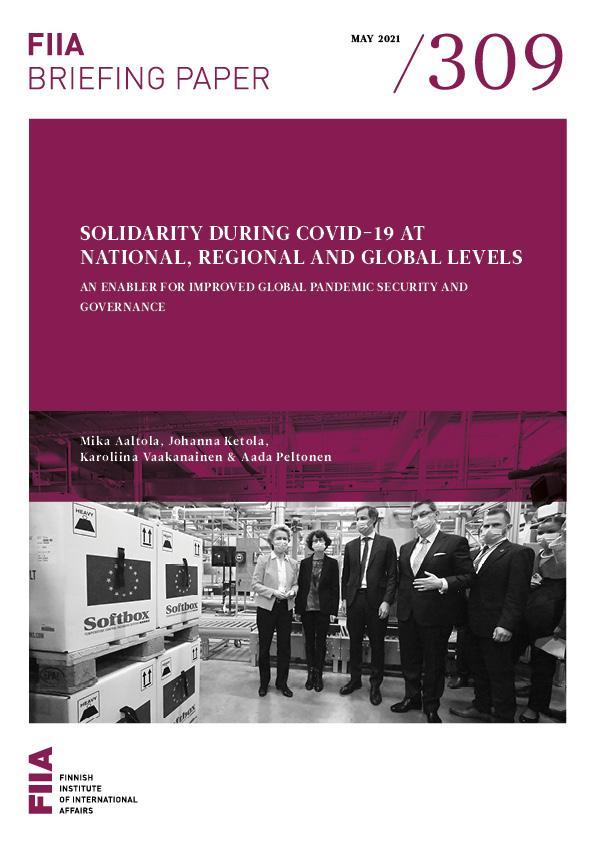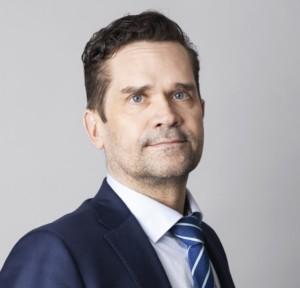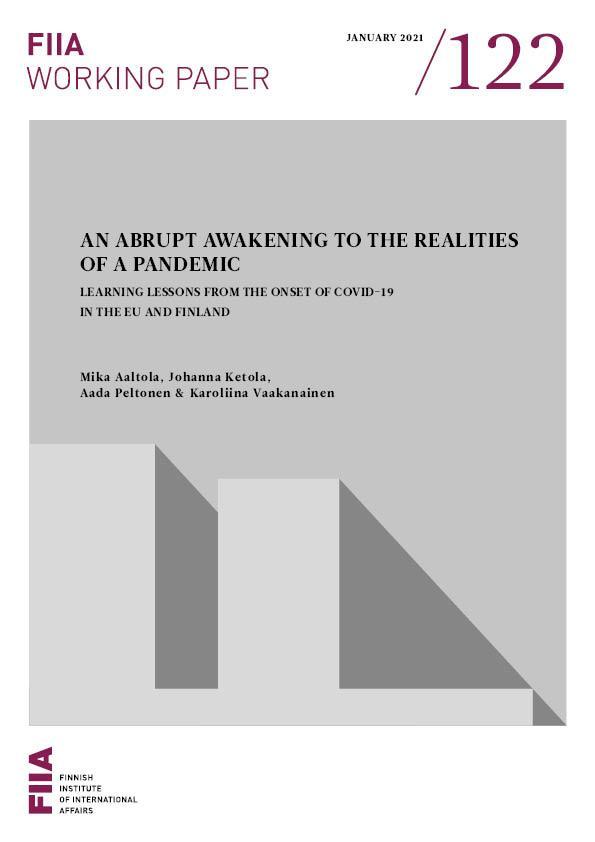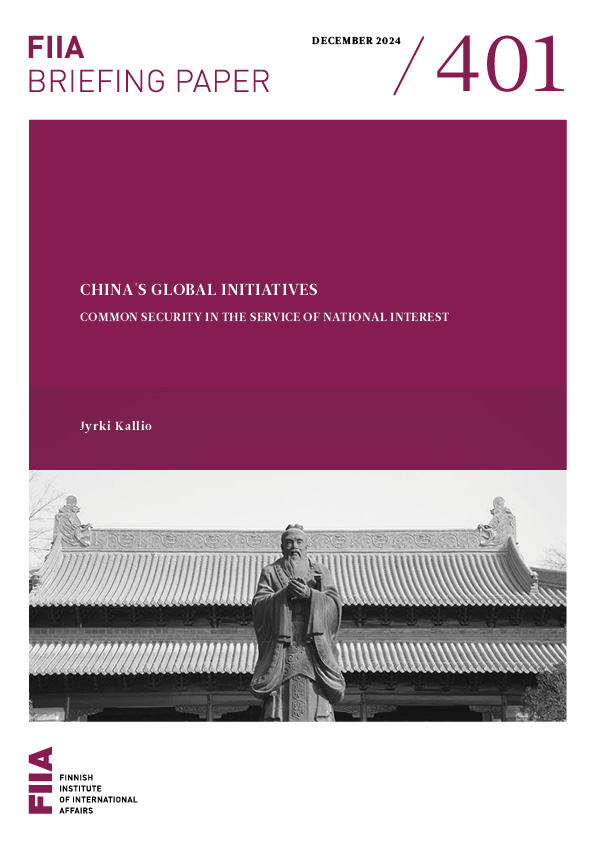- Solidaarisuus tuli osaksi koronaviruspandemian poliittista retoriikkaa välittömästi pandemiajulistuksen jälkeen maaliskuussa 2020. Sittemmin termiä on käytetty luonnehtimaan vastuunkantoa, yhteistyötä ja myötätuntoa One World, One Health -periaatteen mukaisesti.
- Kun YK:n johto on kannattanut globaalia solidaarisuutta, EU:lle se on tarkoittanut taakanjakoa. Solidaarisuus on näyttäytynyt käytännön yhteistyönä ja avunantona. Lisäksi solidaarisuusretoriikka on liittynyt usein rokotteisiin.
- Suomessa solidaarisuudella on ollut eri merkityksiä: kansallisesti solidaarisuus on viitannut yhteiskunnan kriisinkestävyyden vahvistamiseen, kun taas ulkoisessa toiminnassa kyse on ollut kansainvälisen hyvinvoinnin ja turvallisuuden parantamisesta.
- Solidaarisuus voi toimia globaalin pandemianhallinnan mahdollistajana, mutta vain mikäli kansallisen ja paikallisen tason solidaarisuus kytketään siihen. Solidaarisuudella on maailmanlaajuista vetovoimaa ja termiä voidaan hyödyntää strategisessa viestinnässä.
Introduction
Solidarity has become a global and regional buzzword in the fight against Covid-19. As a result of the unequal and shifting disease burden and resource scarcity among countries, solidarity has manifested itself in various forms depending on the national and regional contexts and disease situations.
Politicians worldwide have called for solidarity, which has taken many shapes and forms. At the national and sub-national level, Covid-19 has prompted calls for communal solidarity. Solidarity, at the EU level, has often been used as a synonym for intra-EU coordination and assistance between member states as well as safeguarding the welfare of EU citizens. In the global arena, UN and WHO leadership has been pushing for global solidarity to highlight the global nature and scope of the crisis, simultaneously alluding to the uneven distribution of vaccines and the embedded systemic injustices in global health governance. This mosaic of solidarities differs from the normative ideal.
In this Briefing Paper, we explore the different types of pandemic solidarities to understand the political discourse during the first year of the Covid-19 pandemic. We analyze the solidarity rhetoric of the high political leadership as well as key solidarity initiatives at three different governance levels: global (UN), regional (EU), and national (case Finland) to see how solidarity has been defined, in which context, and to what ends.
Compared to other types of emergencies, pandemics are in a league of their own. One key characteristic of a pandemic emergency is the anxiety connected to the processes of contagion, infection, and spread. As the term ‘pandemic’ signifies, the first line of defence at the local level has failed, as happened in the initial stage of Covid-19. Whereas natural catastrophes are usually locally contained without additional concerns stemming from the fear of spread, pandemics are, to a degree, anti-humanitarian by their very nature. They usually lead to a knee-jerk reaction to step back and buffer oneself to prevent the harm from spreading.[1] From this perspective, pandemic solidarity is far more limited and qualitatively different. Instead of compassion for distant others, a nearest-and-dearest approach can ensue.
This Briefing Paper argues that lower levels of solidarity should act as enablers for better pandemic governance at the global level. Until now, the impact of national and regional solidarity has been relatively bleak. Calls for solidarity can act as empty signifiers or merely as political rhetoric that is not tied to any concrete effort or action. To shed light on the meanings of solidarity, it is important to identify and distinguish the operative nature of solidarity, or lack thereof, in various contexts.
Solidarity at the global level
An overwhelming number of policy actions were activated by the WHO’s pandemic declaration on 11 March 2020. The instrumentalization of solidarity started immediately at the international level. An illustrative example of this was the establishment of the UN Covid-19 Solidarity Response Fund – only two days after the declaration – with the aim of attracting both private and public funding for the WHO’s pandemic response worldwide. Labelling pandemic mechanisms and instruments “solidarity” tools has been a general feature of solidarity in the UN context. In the UN’s words and deeds, solidarity is an intent to mobilize cooperation in a globalized and co-vulnerable world.
UN Secretary General António Guterres defined the pandemic in his landmark speech on 19 March 2020 as “above all, a human crisis that calls for solidarity. Our human family is stressed […] global solidarity is not only a moral imperative, it is in everyone's interests”.[2] Global solidarity as advocated by Guterres can be seen as the opposite of national, border-focused solidarity, which is motivated by domestic solidarity based on the self-protection of one’s own citizens and expressing national self-interest.[3] Guterres and the Director-General of the WHO, Tedros Adhanom Ghebreyesus, have also repeatedly called for ‘human solidarity’ during the Covid-19 pandemic. Humanitarianism or humanitarian solidarity is, however, a disputed term due to its connotations of apolitical action focusing on reactions to emergencies rather than on long-term prevention and recovery, although it is seen as morally pursuable or admirable. The transition from humanitarian solidarity towards genuine global solidarity requires global cooperation based on a rational One World, One Health[4] approach, where the vulnerability of people is interlinked in a globalized world. This would imply that the global health security system would need to be revisited and the relationship built on a more equal long-term basis by investing in healthcare and global preventive and surveillance programmes.
The above-mentioned solidarity fund was established to deliver supplies, vaccines, information, and research across the globe. During its first year, it raised about 240 million US dollars; however, much more was needed, as the goal for 2021 is close to 2 billion dollars. When comparing the expressions of solidarity to the actual contributions to the common effort, there is evidently a clear disconnect.
The race for vaccines has been subjected to great-power competition and unequal relationships between actors in the international system. The vaccine-producing nations, the so-called club of 13, should be aiming towards global efforts since the virus and its mutability know no borders. It is no surprise that the UN has been warning against vaccine nationalism and has advocated support for the poorest and weakest in the international system. Throughout the crisis, the UNSG has called for global unity and solidarity between people and nations. Yet the reality has been quite different.
Covid-19 vaccine diplomacy has been represented by four key actors: the EU, India, China, and Russia. Previously, the US, due to its history as an important player in the field of global health security, logistics and vaccine production, would have been a critical actor as well. However, during the Covid-19 crisis it has been more concerned with its domestic politics, with the Trump administration deciding not to officially join the global vaccine procurement facility COVAX, which is supported by the WHO and Gavi, the Vaccine Alliance. The newly elected President Biden hailed US support for COVAX at the end of January 2021, taking a more prominent role in the global fight against Covid-19. The new Biden administration has pledged to deliver a significant number of doses, but only after the US population is adequately vaccinated.
With the US out of the game for the better part of 2020, the EU together with India found itself with an opening to take the leading role as the protector of multilateralism against Russia’s and China’s interests. Ursula von der Leyen, President of the EU Commission (PEC), acclaimed COVAX as “the best route for universal vaccine solidarity”,[5] making it the torchbearer of global vaccine solidarity. While the EU has been focusing on supporting the distribution of vaccines globally through a multilateral framework, Russia and China have concentrated on vaccine diplomacy through bilateral agreements with countries. However, China also joined COVAX’s multilateral pandemic efforts. In February 2021, China announced its plans to provide COVAX with 10 million vaccine doses.[6]
EU and solidarity as action-oriented cooperation
There is no common perception among member states of what EU solidarity means. Mainstream understandings can be roughly divided into two, a broader and a narrower one. In the former sense, solidarity entails self-interested action across the policy areas with the underlying assumption that what happens to or in a member state can happen in or to another. Understood in this manner, solidarity is based on reciprocal responsibility and recognition of mutually shared vulnerability. In the latter sense, solidarity is closely associated with the solidarity clause (Article 222 of the Treaty on the Functioning of the European Union), which refers to joint action and providing assistance among the EU member states in the area of common security and defence. This narrow understanding mainly refers to institutionalized forms of solidarity and is also embedded in the efforts to strengthen the EU’s strategic autonomy, both internally and externally.
Throughout the pandemic crisis, the Commission, and particularly the PEC, has emphasized the phrase “solidarity in action” when referring to concrete examples where assistance between countries has been offered successfully. This was evident in the speech that the PEC gave on 19 March 2020 in the context of the first-ever common European reserve of emergency medical equipment: with this gesture, “we put EU solidarity into action. It will benefit all our Member States and all our citizens. Helping one another is the only way forward”. During the Covid-19 pandemic, the EU Commission talked about three types of EU solidarity mechanisms based on shared responsibility and action: financial assistance, namely matters of economy (SURE), the EU budget and NextGenerationEU, and the joint procurement of PPE and pharmaceutical instruments in addition to vaccines.
While the EU Commission hailed the EU’s common vaccine procurement as the epitome of EU solidarity, the vaccine companies made it difficult for the EU to call it a success. To a large extent, the global production of vaccines is accomplished by multinational corporations with global production facilities. The One World, One Health approach is heavily dependent on private companies and their intellectual property rights in a globalized world. Vaccine production sites are mutually dependent as the production system is based on global value chains. Member states and the EU can regulate vaccine development, approval, and exports but they do not directly produce vaccines. Export restrictions can create bottlenecks and delays in the overall production. Vaccine ‘wars’ and vaccine nationalism can easily hamper the production and undermine the delivery of vaccines, particularly to places that are not part of the vaccine producers’ club, as well as delivery of the necessary vaccine components among the club.
Even though the EU has stated that it is responsible for supporting the global vaccine effort, the global vaccine agenda is also embedded in the EU’s strategic autonomy interests, through which it tries to define its place in the global world through a multilateral framework. Common global efforts – the key to well-governed expressions of solidarity – have been sorely needed. Although the EU is a traditional supporter of multilateralism and a strong supporter of the WHO’s normative work, several member states have failed to provide core voluntary contributions to the organization.
The EU has declared that it is ready to take the leading role in efforts to achieve global vaccine solidarity. However, the EU’s geopolitical interests and global solidarity are mainly aimed at neighbouring countries. While the EU has implemented export restrictions towards wealthy vaccine-producing countries such as the UK, the US and Australia, countries in the Western Balkans, North Africa and the Mediterranean area have been spared these restrictions.[7]
The slow vaccine rollout, the production difficulties experienced by the vaccine companies, and the EMA taking its time approving vaccines have served to create a favourable platform for EU countries to disregard European vaccine solidarity. Many countries, such as Hungary, have replaced the EU-wide solidarity with national solidarity by acquiring vaccines for their own citizens outside of the EU framework. It is debatable whether the EU, with its high and mighty ideas of solidarity in its vaccine strategy, has shot itself in the foot in view of its difficulties in distributing vaccines to member states. However, PEC von der Leyen still stands behind the EU’s joint procurement.
Overall, the pandemic has changed the discussion related to the EU’s strategic autonomy towards health and welfare matters. If a member state hopes to receive and provide help within the EU, it needs to reassess its contribution from a cross-sectoral perspective specific to the situation at hand. While the EU’s call for global vaccine solidarity is, to a degree, working in tandem with the EU’s geopolitical interests, in order for the EU to state its position as the main proponent of multilateralism, it may need to compromise its unity, since the vaccines and vaccine restrictions have raised the question of where the EU’s and its member states’ solidarity lies – with the global world or within the EU?
Finland – a case of mundane solidarity with limited global outreach
Solidarity in the Finnish Covid-19 context can be characterized as a tool for resilience-building. It is a rather mundane term, a mixture of pragmatic resilience towards oneself and others, and a normative sense of community in the crisis. This tool is used to advance and reinforce a common understanding of the crisis, as well as protect the population from the disease burden.
Finland’s solidarity is based on its response, as along with Norway it has been able to contain the first waves of Covid-19 relatively well among European countries. The two countries have strong solidaristic Nordic welfare state institutions in common. This sets a standard for a human-centred approach based on societal trust, and implements good governance. At the same time, Finland has benefitted from the EU-level vaccine purchasing programme, which distributes vaccines according to population size. The lack of solidarity is a hot topic within member states, including Finland, where there is currently domestic pressure to direct vaccines to those areas of the country where the disease load is highest.
The main figure in the Finnish solidarity landscape has been President Sauli Niinistö, who was particularly active at the beginning of the pandemic crisis and in relation to the EU. Only a day after Covid-19 was characterized as a pandemic, Niinistö discussed the importance of communal solidarity in preventing the disease with EU High Representative and Vice-President of the Commission Josep Borrell, referring to European solidarity within the Union. With his tweet about “physical distance, but mental proximity in Europe”, Niinistö extended the perception of solidarity and resilience outside of national borders. In Niinistö’s view, the perception of European solidarity should be extended from financial solidarity to other fields, especially security.[8]
The issue of global solidarity became more relevant as discussions on vaccines were placed high on the political agenda as of November 2020. At this juncture, Prime Minister Sanna Marin started speaking in terms of global solidarity, referring to a common crisis with the underlying tone of “One Health, One World”.[9]
In early 2021, EU vaccine solidarity became a political topic in Finland, thrusting Foreign Minister Pekka Haavisto into the limelight. He was asked in parliament about the petition he had co-signed along with other European Foreign Ministers requesting the Commission to extend COVAX procedures outside the EU’s borders. Haavisto replied by defending the petition and its aim of helping EU neighbourhood countries with the procurement of vaccines. Furthermore, Haavisto clarified that vaccine solidarity referred to a future situation after EU citizens had been vaccinated. He stated that the total quantity of vaccines that the EU had succeeded in procuring exceeded the amount needed within the EU, duly making it possible to help those in need via COVAX.[10]
Solidarity has an important security policy meaning for Finland. Finland’s focus on welfare and security is embedded in the latest government report on Foreign and Security Policy, where the EU is seen as a security community through a lens of solidarity and mutual assistance. Finland has committed to the EU as a financial and security project, which also remains the main way of contributing to global solidarity. Thus, Finland’s interests can chime well with the EU’s efforts, but the contribution can easily be insufficient if the perception of the situation lacks a shared understanding of necessary action at all of the stated levels.
Dilemmas of national and global solidarity
Calls for a global approach can also be seen as an expression of national interest. In the field of pandemic security, omitting vast parts of the world creates a scenario akin to a ticking timebomb. The virus develops variants which, over the long haul, can penetrate the protection provided by vaccines. As a consequence, self-interest and solidarity can be seen as one and the same in pandemic emergency situations, when pursuing security from the disease is understood to benefit all. Self-interest can be an effective driver for common interest. Simultaneously, this common interest can be co-opted by the bigger players’ interests. Yet the actors can share a common goal and discard the pre-existing biases to achieve global solidaristic ends.
National exceptionalism in relation to vaccines in particular can be equipped to serve global solidaristic efforts, but entails the danger of othering and bordering practices. This can reinforce pre-existing divides and lead to vaccine nationalist approaches and even vaccine ‘wars’ if the effort is not identified as common to everyone.[11]
Although politicians have both voiced their concern over the situation and showed support for common action, the actual commitment to global solidaristic action might suffer if the calls for solidarity are merely empty signifiers without a concrete basis to build on. Additionally, national political agendas may contradict those of a global nature, as we have shown in the case of COVAX, where disputes have appeared between and within the member states.
The cost-benefit analysis preceding one’s choice to take part in common action tends to lean more towards rationality. Global solidarity, in turn, stems from identification, mutual understandings of the situation, support and cooperation, as well as burden-sharing, which stems from the recognition of co-vulnerabilities and dependencies. If the approach is solely based on self-interest calculations, the imperative for cooperation can become weakened and suspect. As global solidarity sometimes calls for normative visions, the calculating approach of national solidarity is often at odds with the realization of genuine global solidarity, where the driving forces stem from a shared identity, sentiments of affinity, and situation sensitivity.[12]
Conclusion
Irrespective of the governance level, three features are common to the solidarity rhetoric. Firstly, solidarity is an instrument for improving coordination and cooperation. Secondly, solidarity entails sharing responsibility among individuals and other countries. Thirdly, solidarity has been an empty signifier, a filler word, for much narrower national and regional compassion politics. If calls for solidarity remain mere political rhetoric without a concrete action or goal, the last feature risks becoming the dominant one.
Expressions of solidarity are motivated by political factors. Geopolitical considerations co-opted expressions of solidarity to a degree, for example in PPE and vaccine diplomacy. Recognized forms of solidarity usually acquire justification and legitimacy from the lower national levels of solidarity, where political accountability is felt most tangibly. In other words, if the lower levels lack solidarity, the higher levels of regional and global governance will most likely suffer from this as well.
We suggest that in order for solidarity to work for better pandemic governance at the global level, national and local levels of solidarity need to act as enablers and drivers. Solidarity as such seems to have a global appeal, and can best be mobilized in strategic communication. That said, pandemic emergencies differ from the usual well-established patterns of humanitarian crises. The key difference is the fear of contagion, which can overwhelm the usual patterns of solidarity expression and turn communities inwards. Even before the Covid-19 crisis is over, we must recognize that we are building readiness and resilience for the next global crisis, and setting a precedent for the next inevitable pandemic emergency.
Endnotes
[1] Mika Aaltola, Understanding the Politics of Pandemic Scares: An Introduction to Global Politosomatics (London: Routledge, 2012), 1.
[2] United Nations, Secretary-General’s opening remarks at virtual press encounter on COVID-19 Crisis, 19 March 2020, https://www.un.org/sg/en/content/sg/speeches/2020-03-19/remarks-virtual-press-encounter-covid-19-crisis.
[3] Mika Aaltola, ‘Spectre of Thucydides: Pandemic Catalyzes Deepening Regressive Trajectories’, in Democratic Vulnerability and Autocratic Meddling (New York: Palgrave Macmillan, 2020).
[4] One World, One Health refers to a global initiative embedded in the UN with the aim of minimizing the effect of zoonotic diseases, recognizing the interdependence between human, animal and ecosystem health. FAO, OIE & WHO, ‘One World, One Health: Summary of the FAO/OIE/WHO document’, 2009, https://www.oie.int/doc/ged/D6296.PDF.
[5] European Commission, Statement by President von der Leyen at the joint press conference with President Michel, following the EU Leaders’ videoconference, 21 January 2021, https://ec.europa.eu/commission/presscorner/detail/en/statement_21_189.
[6] On US exports, see e.g. Deutsche Welle, 18 March 2021, https://www.dw.com/en/coronavirus-digest-us-to-send-first-vaccine-exports-to-mexico-canada/a-56908883. On China, see e.g. The Diplomat, 23 October 2020, https://thediplomat.com/2020/10/did-china-join-covax-to-counter-or-promote-vaccine-nationalism/ ; Reuters, 3 February 2021, https://www.reuters.com/article/us-health-coronavirus-vaccine-china-idUSKBN2A30VZ.
[7] European Commission, EU Strategy for COVID-19 vaccines, COM/2020/245 final, 17 June 2020, https://eur-lex.europa.eu/legal-content/EN/TXT/?qid=1597339415327&uri=CELEX:52020DC0245.
[8] Sauli Niinistö, ‘Presidentti Niinistö keskusteli EU:n korkean edustajan Josep Borrellin kanssa’, 12 March 2020, https://www.presidentti.fi/uutinen/presidentti-niinisto-keskusteli-eun-korkean-edustajan-josep-borrellin-kanssa/; Sauli Niinistö, ‘Presidentti Niinistö keskusteli EU-komission puheenjohtajan Ursula von der Leyenin kanssa’, 19 March 2020, https://www.presidentti.fi/uutinen/presidentti-niinisto-keskusteli-eu-komission-puheenjohtajan-ursula-von-der-leyenin-kanssa/; Uusi Suomi, 16 June 2020, https://www.uusisuomi.fi/uutiset/presidentti-sauli-niinisto-nosti-esiin-kylmat-terveiset-usasta-tallaiseen-poytaan-on-paastava/280142c2-b4e7-4a0d-a922-4d7fcc993fbd.
[9] Ilta-Sanomat, 28 November 2020, https://www.is.fi/politiikka/art-2000007647971.html.
[10] Ilta-Sanomat, 6 January 2021, https://www.is.fi/kotimaa/art-2000007723535.html; Pekka Haavisto, 2021, Vastaus kirjalliseen kysymykseen KKV 991/2020 vp, https://www.eduskunta.fi/FI/vaski/Kysymys/Documents/KKV_991+2020.pdf.
[11] See e.g. Johanna Vuorelma, ‘Koronakriisi ja kamppailu tarinasta’, 2 April 2020, https://politiikasta.fi/koronakriisi-ja-kamppailu-tarinasta/; and Saila Heinikoski et al., ‘Kosmopolitanismi ja kansalaisuuden rajat – Suomen ja Irlannin rajatoimet koronakriisissä’, Kosmopolis 51(1), (2021): 54-71.
[12] See e.g. P. T. Lenard, C. Straehle, & L. Ypi, ‘Global solidarity’, Contemporary Political Theory, 9(1), (2010): 99-130; B. Prainsack, & A. Buyx, ‘Solidarity in contemporary bioethics – towards a new approach’, Bioethics, 26(7), (2012): 343-350.








